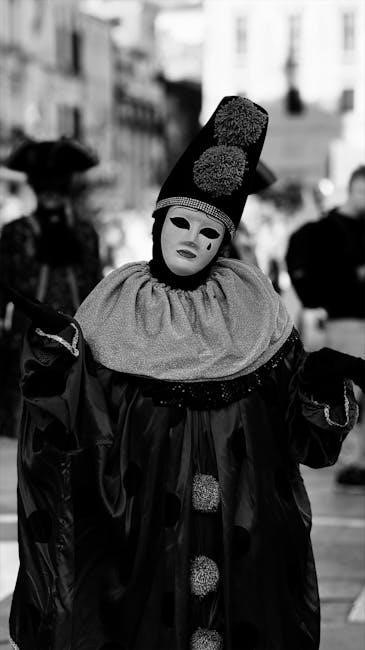Harlan Ellison’s “Repent, Harlequin! Said the Ticktockman” is a dystopian tale exploring themes of time, conformity, and rebellion․
The story follows the Harlequin, a defiant figure challenging a society where punctuality is enforced ruthlessly․
This satirical narrative critiques authoritarian control, resonating with its timeless relevance and cultural impact․
Ellison’s unique voice and vivid imagery make it a landmark in science fiction literature․
Overview of the Story
Set in a dystopian future, “Repent, Harlequin! Said the Ticktockman” by Harlan Ellison explores a society where time is rigidly controlled․ The story centers on the Harlequin, a rebellious figure who defies the oppressive regime led by the Ticktockman, a tyrannical enforcer of punctuality․ The Harlequin’s acts of defiance, such as being late and spreading chaos, challenge the system that values time above all else․ As punishment, the Harlequin is sent to Coventry, a place of brutal reconditioning․ The narrative blends satire and surrealism, critiquing authoritarian control and the dehumanizing effects of strict conformity․ The story’s themes of rebellion and individuality remain poignant, resonating with readers in its exploration of freedom versus societal constraint․

Historical Context and Significance
Written in 1965 by Harlan Ellison, “Repent, Harlequin! Said the Ticktockman” reflects the societal anxieties of the Cold War era, critiquing authoritarianism and technological control․ The story’s exploration of time as a commodity and its satirical take on conformity resonated deeply, earning it the Hugo and Nebula Awards․ Its influence on dystopian literature is profound, inspiring numerous adaptations, including potential film rights granted in recent years․ The narrative’s themes of rebellion and individuality continue to resonate, making it a timeless commentary on freedom and oppression․ PDF versions and study guides have further cemented its place in academic and literary discourse, ensuring its enduring relevance in contemporary discussions of societal control and dissent․
Themes and Symbolism
At its core, “Repent, Harlequin! Said the Ticktockman” explores themes of rebellion, time commodification, and individuality versus conformity․ The Harlequin symbolizes resistance against oppressive authority, while the Ticktockman embodies the rigid, mechanized society that values punctuality above humanity․ Time is portrayed as a currency, controlled and stolen by the state, highlighting the loss of personal freedom․ The story’s satirical tone critiques authoritarianism and societal conditioning, urging readers to question conformity․ The Coventry serves as a symbol of psychological reprogramming, mirroring Orwellian themes of control․ Ellison’s use of vivid imagery and irony underscores the clash between creativity and mechanization, making the narrative a powerful allegory for modern societal pressures․
Plot Summary
In a dystopian future ruled by time tyranny, the Harlequin defies the Ticktockman, who enforces punctuality․ Despite being late, the Harlequin resists control, leading to his punishment and eventual defiance․

The World of the Ticktockman
In Harlan Ellison’s “Repent, Harlequin! Said the Ticktockman,” the story unfolds in a dystopian future where time is meticulously regulated and controlled by the Ticktockman․
Society is governed by the relentless tyranny of punctuality, where being late is a grave offense punishable by the deduction of time from one’s life․
The Ticktockman, the enforcer of this rigid system, ensures that every individual adheres to the strict schedule, leaving no room for rebellion or individuality․
The world is a mechanical, clockwork society where time is treated as a commodity, and any deviation from the norm is met with harsh consequences․
This oppressive environment fosters a culture of fear and conformity, suppressing creativity and freedom, as the Ticktockman’s authority looms over all aspects of life․
The Harlequin’s Rebellion
The Harlequin, a colorful and defiant figure, emerges as the central character opposing the oppressive regime of the Ticktockman․
His rebellion is marked by acts of defiance, such as releasing thousands of jellybeans on the Master Timekeeper’s desk and disrupting the rigid schedule․
The Harlequin’s actions symbolize a rejection of the society’s mechanized control, advocating for individuality and freedom․
Despite being sent to Coventry, a place of psychological reprogramming, the Harlequin’s spirit remains unbroken, inspiring others to question authority․
His rebellion is not just a personal act but a broader critique of a society that values efficiency and conformity over human creativity and dissent․
The Role of the Ticktockman

The Ticktockman is the enforcer of time discipline in a society where punctuality is absolute․
He serves as the embodiment of authoritarian control, monitoring and punishing those who waste time․
His role is to maintain the rigid schedule, deducting microseconds from offenders’ lives for every moment of tardiness․
The Ticktockman represents the oppressive machinery of the state, ensuring conformity through fear and precision․
His interaction with the Harlequin highlights the clash between individuality and societal control, as he seeks to suppress rebellion․
Ultimately, the Ticktockman’s actions reveal the cost of dissent in a world where time is a strictly controlled resource․
Climax and Resolution
The climax unfolds as the Harlequin defies the Ticktockman, refusing to repent despite the severe consequences․
The Ticktockman, after calculating the Harlequin’s extensive time debt, decides not to end his life but to send him to Coventry․
This place resembles a reconditioning center, akin to Winston Smith’s fate in Orwell’s 1984, where dissent is erased․
The resolution underscores the cost of rebellion, as the Harlequin’s spirit is broken, and he is reintegrated into society․
This ending highlights the oppressive system’s resilience and the personal toll of challenging authority․
The story concludes with a chilling reminder of the consequences of nonconformity in a rigidly controlled world․
Main Characters
The Harlequin is the rebellious protagonist who defies the oppressive time-keeping society․
The Ticktockman enforces punctuality, embodying the dystopian regime’s ruthless control․
Their conflict highlights individuality versus conformity in a society governed by time․
The Harlequin
The Harlequin is the story’s protagonist, a rebellious figure who defies the rigid time-obsessed society․
With his colorful appearance and chaotic actions, he symbolizes freedom and individuality․
He rejects the Ticktockman’s authority, refusing to conform to societal norms․
His defiance is both a personal statement and a broader critique of authoritarian control․
Through his actions, Ellison explores themes of dissent and the cost of rebellion․
The Harlequin’s character serves as a powerful symbol of resistance against oppressive systems․
The Ticktockman
The Ticktockman is the enforcer of time in a dystopian society where punctuality is paramount․
He embodies the oppressive authority, meting out punishments for any deviation from schedules․
Armed with the power to steal time from offenders, he enforces conformity through fear․
The Ticktockman’s role is to maintain order, yet his actions reveal the system’s cruelty․
He is both a symbol of control and a figure of dread, central to the story’s exploration of authoritarianism․
Despite his strict demeanor, his decision regarding the Harlequin adds depth to his character․
The Ticktockman represents the machinery of oppression, highlighting the tension between individuality and societal control․
Other Supporting Characters
Beyond the Harlequin and the Ticktockman, the story features minor characters who inhabit the dystopian world․
These include the Master Timekeeper, who oversees the strict scheduling of society, and Everett C․ Marm, a figure tied to the Harlequin’s rebellion․
They serve to highlight the oppressive nature of the regime and the consequences of dissent․
While not fully developed, these characters add depth to the narrative, illustrating the societal roles within the time-obsessed culture․
Their presence underscores the pervasive control of the Ticktockman and the broader implications of the Harlequin’s defiance․
These supporting figures, though limited in scope, enrich the story’s exploration of conformity and rebellion․

Themes and Messages
Harlan Ellison’s “Repent, Harlequin! Said the Ticktockman” explores themes of rebellion against oppressive authority, the commodification of time, and the tension between conformity and individuality․
It critiques societal control mechanisms and the cost of dissent, highlighting the struggle for personal freedom in a rigidly structured world․
The story underscores the consequences of nonconformity, emphasizing the importance of autonomy and the human spirit’s resistance to systemic oppression․
Rebellion Against Authority
In “Repent, Harlequin! Said the Ticktockman,” the Harlequin embodies the spirit of rebellion against a society governed by rigid timekeeping and oppressive authority․
His defiance, marked by deliberate tardiness and chaotic pranks, challenges the Ticktockman’s regime, which enforces punctuality with brutal efficiency․
The Harlequin’s actions symbolize resistance against the dehumanizing effects of a society that values order over individuality․
By rejecting the constraints of time regulation, he asserts his humanity and free will, even in the face of severe consequences, such as being sent to Coventry․
Ellison’s portrayal of the Harlequin’s rebellion underscores the tension between conformity and personal freedom, highlighting the cost of dissent in a totalitarian system․
The story serves as a powerful critique of authoritarian control and a celebration of the individual’s right to challenge oppressive structures․
Time as a Commodity
In “Repent, Harlequin! Said the Ticktockman,” time is treated as a scarce and tightly controlled resource․
The society enforces strict punctuality, with every moment accounted for and regulated by the Ticktockman․
Individuals are penalized for any time wasted, deducted from their lifespan, emphasizing time’s value as a commodity․
This system dehumanizes people, reducing them to machines governed by the clock․
The Harlequin’s rebellion against this regime highlights the oppressive nature of such a system․
Ellison critiques a society where time is commodified, arguing for the importance of personal freedom and spontaneity․
The story explores the consequences of a world where efficiency and order are prioritized over human emotions and creativity․
Conformity vs․ Individuality
In “Repent, Harlequin! Said the Ticktockman,” the struggle between conformity and individuality is central․
The Ticktockman enforces societal norms, demanding absolute adherence to time and order․
The Harlequin’s rebellious actions, such as being late and disrupting routines, symbolize a rejection of conformity․
Ellison portrays a society where individuality is suppressed, and those who defy norms are harshly punished․
The Harlequin’s defiance, despite knowing the consequences, underscores the importance of personal freedom․
This tension between conformity and individuality serves as a cautionary tale about the loss of identity in rigidly controlled societies․
The story highlights the need for autonomy and creativity in a world that values uniformity above all else․
The Cost of Dissent
In “Repent, Harlequin! Said the Ticktockman,” the cost of dissent is severe and far-reaching․
The Harlequin’s rebellion against the rigidly controlled society results in brutal punishment, including time deductions and public shaming․
The Ticktockman’s authority ensures that any form of disobedience is met with harsh consequences, such as being sent to Coventry for “reeducation․”
This reflects the societal fear of nonconformity and the lengths to which authoritarian regimes will go to maintain control․
Ellison’s depiction of the Harlequin’s suffering serves as a powerful critique of systems that suppress individuality and dissent․
The story underscores the enduring theme that rebellion, though costly, is essential for challenging oppressive structures and preserving human freedom․
Literary Style and Devices
Ellison’s narrative voice in “Repent, Harlequin! Said the Ticktockman” blends satire, irony, and surrealism, creating a unique storytelling experience․
The use of vivid imagery and symbolic characters highlights the themes of rebellion and societal control․
The story’s structure and pacing amplify its dystopian tone, while the dialogue drives the moral and philosophical underpinnings of the narrative․
Ellison’s Unique Narrative Voice
Harlan Ellison’s prose in “Repent, Harlequin! Said the Ticktockman” is a masterclass in blending satire, irony, and surrealism․
His narrative voice is both intense and poetic, capturing the defiance of the Harlequin and the oppressive rigidity of the Ticktockman․
Ellison’s use of vivid imagery and sharp dialogue creates a sense of urgency, while his unique storytelling style challenges readers to reflect on societal norms․
The story’s chorus-like repetitions and elliptical structure enhance its dystopian themes, making it a standout in speculative fiction․
Ellison’s voice remains unapologetically bold, ensuring the tale’s relevance and impact endure long after the final sentence․
Use of Satire and Irony
Harlan Ellison masterfully employs satire and irony in “Repent, Harlequin! Said the Ticktockman” to critique societal norms and authoritarian control․
The story’s dystopian setting, where time is rigidly controlled, serves as a satirical commentary on modern society’s obsession with punctuality and conformity․
The Ticktockman, a figure of relentless order, embodies the absurdity of bureaucratic power, while the Harlequin’s defiance highlights the futility of absolute control․
Ellison’s use of irony is evident in the contrast between the Harlequin’s playful rebellion and the Ticktockman’s draconian enforcement of time․
This blend of satire and irony not only underscores the story’s themes but also elevates its critique of oppressive systems, making it a timeless commentary on individuality and freedom․
Symbolism in the Story
The story is rich in symbolism, with the Harlequin representing rebellion and chaos against a rigidly controlled society․
The Ticktockman symbolizes oppressive authority, embodying the relentless enforcement of time as a commodity․
The jellybeans the Harlequin throws signify defiance and unpredictability, challenging the order imposed by the Ticktockman․
Time itself is a central symbol, highlighting the societal obsession with punctuality and the dehumanizing effects of strict control․
The Coventry, where the Harlequin is sent, symbolizes isolation and the consequences of dissent․
These symbols collectively explore themes of conformity, freedom, and the cost of rebellion in a dystopian world․
Structure and Pacing
The story’s structure is fragmented and non-linear, reflecting the chaos of the Harlequin’s rebellion against a rigidly controlled society․
Ellison’s pacing is frenetic, mirroring the relentless nature of time in the dystopian world․
The narrative jumps between the Harlequin’s defiance and the Ticktockman’s oppressive authority, creating a sense of tension․
Dialogue and descriptive passages are interwoven to emphasize the clash between individuality and conformity․
The pacing accelerates toward the climax, highlighting the inevitability of the Harlequin’s fate․
This structure enhances the story’s satirical and surreal elements, underscoring its themes of rebellion and control․

Cultural Impact
Ellison’s story has left a lasting mark on science fiction, inspiring adaptations and influencing writers worldwide․
Its exploration of time and rebellion remains relevant, earning it a place in literary and educational contexts․
Reception and Reviews
Harlan Ellison’s “Repent, Harlequin! Said the Ticktockman” received widespread critical acclaim for its bold narrative and satirical depth․
It won the Hugo and Nebula Awards, solidifying its place in science fiction history․
Readers praised its exploration of time as a commodity and rebellion against authority․
The story’s surreal style and sharp commentary resonated with audiences, making it a classic․
Its themes of conformity and dissent continue to spark discussions in educational and literary circles․
Study guides and analyses highlight its relevance, ensuring its enduring popularity․
The PDF version remains a sought-after resource for fans and scholars alike․
Awards and Recognition
Harlan Ellison’s “Repent, Harlequin! Said the Ticktockman” earned the prestigious Hugo Award in 1966 and the Nebula Award in 1965․
This dual recognition highlighted its groundbreaking narrative and thought-provoking themes․
The story’s success solidified Ellison’s reputation as a visionary in speculative fiction․
Its inclusion in various anthologies and collections further cemented its status as a classic․
The PDF version remains widely sought after, reflecting its enduring influence․
This tale of rebellion and time control continues to inspire new adaptations and interpretations․
Its timeless relevance ensures its place in the pantheon of dystopian literature․
Influence on Other Works
Ellison’s “Repent, Harlequin! Said the Ticktockman” has inspired numerous adaptations and influenced speculative fiction․
Its exploration of time as a commodity and rebellion against authority shaped dystopian narratives․
The story’s satirical tone and unique structure have been studied in academic circles, as seen in critical essays․
Michael Straczynski’s acquisition of film rights highlights its enduring appeal․
The tale’s themes of conformity and dissent continue to resonate in modern media․
Its influence is evident in literature, film, and even graphic novels, cementing its legacy as a cultural touchstone․
The PDF version remains a sought-after resource for scholars and fans alike, ensuring its ideas persist․
This timeless story continues to spark creativity across genres and mediums, proving its relevance unbound by time․
Modern Relevance
Harlan Ellison’s “Repent, Harlequin! Said the Ticktockman” remains strikingly relevant in today’s fast-paced, technology-driven world․
The story’s themes of time commodification and societal control resonate with modern anxieties about work culture and digital surveillance․
The PDF version circulates widely, ensuring accessibility for new generations of readers․
Its critique of authoritarianism and conformity aligns with contemporary debates on individuality and freedom․
The narrative’s exploration of rebellion mirrors current movements against systemic oppression․
As technology advances, the story’s warning about the dehumanizing effects of rigid control systems feels increasingly pertinent․
Thus, Ellison’s work continues to provoke thought, making it a timeless commentary on humanity’s struggles with time and authority․
Adaptations and Interpretations
Harlan Ellison’s tale has sparked interest in film and stage adaptations, with rights granted to creators like Michael Straczynski, ensuring its enduring appeal across mediums․
Potential Film Adaptations

The story’s cinematic potential has long been recognized, with rights granted to Michael Straczynski, a close friend of Ellison’s․ Straczynski’s involvement promises a faithful adaptation, capturing the story’s complexity and depth․ The narrative’s visual richness and themes of rebellion align well with modern cinematic storytelling․ Discussions about casting and production are ongoing, with fans eagerly awaiting updates․ The challenge lies in translating Ellison’s unique prose into a compelling screenplay while preserving the original’s satirical tone and emotional resonance․ A film adaptation could introduce this classic tale to a new generation, ensuring its legacy endures in the digital age․
Stage and Audio Dramatizations
While no official stage or audio adaptations of “Repent, Harlequin! Said the Ticktockman” have been widely released, the story’s vivid dialogue and satirical tone make it a compelling candidate for such interpretations․ Its themes of rebellion and societal control could be powerfully conveyed through theatrical performances or immersive audio dramas․ The narrative’s surreal elements and sharp wit would translate well into a stage production, while an audio dramatization could emphasize the story’s rhythmic and ironic undertones․ Fans and creators continue to explore these possibilities, drawn to the story’s timeless relevance and emotional depth, ensuring its potential for future adaptations remains strong․
Comic Book and Graphic Novel Versions

While “Repent, Harlequin! Said the Ticktockman” has not been officially adapted into a comic book or graphic novel, its visually rich and satirical narrative lends itself well to such formats․ The story’s themes of rebellion, time control, and societal critique could be vividly portrayed through illustrations, enhancing its emotional and intellectual impact․ Some fan-created artwork and inspired visuals have emerged online, showcasing the potential for a graphic adaptation․ The surreal and dystopian elements of the tale would particularly benefit from the medium’s ability to blend text and imagery, offering a fresh perspective on Ellison’s timeless story․
Fan Art and Inspired Works
Fans of “Repent, Harlequin! Said the Ticktockman” have created a variety of inspired works, showcasing the story’s vivid imagery and themes․ Many artists have visually interpreted the Harlequin’s defiance and the Ticktockman’s oppressive regime, blending surreal and dystopian elements․ Digital illustrations and sketches often highlight the stark contrast between the Harlequin’s colorful rebellion and the monotonous, time-controlled society․ These works, shared on platforms like social media and art communities, demonstrate the enduring appeal of Ellison’s narrative․ They serve as a testament to the story’s ability to inspire creativity and spark reflection on its themes of individuality and resistance․

Availability and Access
“Repent, Harlequin! Said the Ticktockman” is widely available as a PDF, in digital libraries, and as part of collected works․ It can be downloaded or accessed through online platforms and educational resources․

PDF Versions and Digital Formats
PDF versions of “Repent, Harlequin! Said the Ticktockman” are widely available online, including through platforms like libcom․org and educational study guides․
Digital formats such as epub and mobi can also be found, offering accessibility across various devices․
The story is often included in collections of Harlan Ellison’s works, making it easy to download or read online․
Additionally, many websites provide free access to the PDF, allowing readers to explore its dystopian themes and cultural significance․
These digital versions ensure the story remains accessible to modern audiences, preserving its enduring impact on science fiction literature․
Print Editions and Collections
“Repent, Harlequin! Said the Ticktockman” is widely available in print editions, often included in anthologies of Harlan Ellison’s works․
The story has been featured in collections such as The Beast That Shouted Love at the Heart of the World and Paley’s Closet․
Print editions are sought after by fans and scholars for their collectible value and ease of reading․
Many paperback and hardcover versions are available, including a 1967 edition published by Dell․
The story’s inclusion in various “Best Of” science fiction anthologies further highlights its enduring appeal․
Print copies can be found in libraries, bookstores, and through online retailers, ensuring accessibility for readers worldwide․
Study Guides and Educational Resources
Study guides for “Repent, Harlequin! Said the Ticktockman” provide in-depth analysis of themes, characters, and historical context․
These resources, such as those from Gale, offer critical essays and insights into Ellison’s narrative style․
Educational materials often include discussion questions and historical background on dystopian literature․
The story is frequently featured in academic anthologies, making it a popular choice for classroom study․
Study guides highlight the story’s exploration of rebellion, time, and conformity, aiding students in understanding its significance․
These resources are widely available in libraries and online platforms, supporting both student and scholarly research․
Libraries and Archives
Digital versions of “Repent, Harlequin! Said the Ticktockman” are accessible through libraries and online archives․
Many libraries offer PDF downloads and digital formats, making the story widely available for public access․
Archives like the Internet Archive provide free access to the story for educational and research purposes․
Libraries often include Ellison’s works in their collections, ensuring the story’s preservation for future generations․
These resources are invaluable for students and researchers exploring dystopian literature and its cultural impact․
Libraries play a crucial role in maintaining the accessibility and visibility of this seminal work of science fiction․
Harlan Ellison’s “Repent, Harlequin! Said the Ticktockman” remains a timeless critique of authoritarian control and societal conformity․
Its exploration of time as a commodity continues to resonate in modern discourse․
This Nebula Award-winning story endures as a powerful warning against the loss of individuality․
Its influence on dystopian literature and culture solidifies its legacy as a seminal work of science fiction․
Legacy of the Story
Harlan Ellison’s “Repent, Harlequin! Said the Ticktockman” has left an indelible mark on science fiction literature․
Winner of both the Nebula and Hugo Awards, it remains a seminal work in the genre․
Its exploration of time as a commodity and rebellion against authoritarian control continues to resonate with readers․
The story’s themes of individuality and dissent have influenced countless works of fiction and film․
Ellison’s unique narrative voice and satirical tone have cemented its place in literary history․
The tale’s timeless relevance ensures its enduring appeal, making it a cornerstone of dystopian storytelling and a testament to Ellison’s genius․
Its legacy endures as a powerful critique of societal conformity and the human spirit’s struggle for freedom․
Final Thoughts on Its Significance
Harlan Ellison’s “Repent, Harlequin! Said the Ticktockman” stands as a landmark in speculative fiction, offering a searing critique of authoritarian control and societal conformity․
Its exploration of time as a commodity and the cost of dissent remains profoundly relevant in today’s fast-paced, compliance-driven world․
The story’s influence can be seen in numerous works of fiction, film, and media, cementing its place in cultural and literary history․
Ellison’s masterful use of satire and symbolism continues to provoke thought, encouraging readers to question the value of individuality in a rigidly structured society․
As a testament to its enduring appeal, the story remains widely studied and admired, ensuring its message of rebellion and freedom endures for future generations․

Leave a Reply
You must be logged in to post a comment.